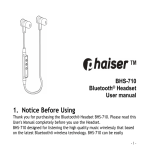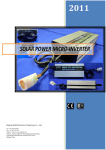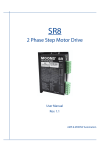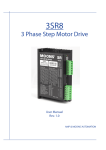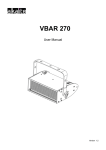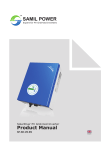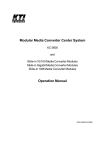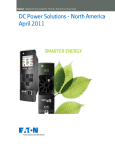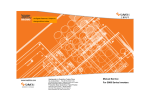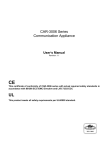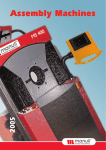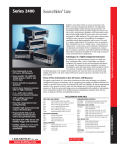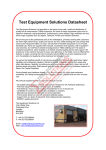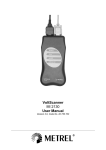Download Preface - ostrovni
Transcript
Preface Thank you for using the pure sine wave inverter of Beijing Multifit Electrical Technology Co., Ltd. This User Manual is about the functions and operation process of the inverter. Please read this User Manual carefully before operation for correctly using the inverter and keep this User Manual properly for future reference in case of any problem. Attentions: ■ This User Manual is subject to change without notice and the latest version prevails. ■ In case of any different understanding of this User Manual, the interpretation from Technology Department of Beijing Multifit Electrical Technology Co., Ltd. prevails. ■ Any copying or rearranging of any part or whole of this User Manual without the written permission from Beijing Multifit Electrical Technology Co., Ltd. is considered as serious infringement. Table of Contents Chapter I Overview 1.1 Product verification 1.2 Safety precautions 1.3 Use precautions Chapter II Product Specification 2.1 Application range 2.2 Types 2.3 Technical specifications 2.4 Description of external structure 2.5 Overall dimensions 2.6 Installation dimensions 2.7 Optional accessories Chapter III Installation and Wiring of Inverter 3.1 Environmental conditions for installation 3.2 Wiring precautions Chapter IV Operation Guide of Inverter 4.1 Operation 4.2 Parameters Chapter V Performance and Parameters of Inverter 5.1 Capacity calculation 5.2 Performance and parameters Chapter VI Battery Management of Inverter 6.1 Battery model selection 6.2 Battery insertion Chapter VII Monitoring Chapter VIII Maintenance 8.1 Daily maintenance 8.2 Periodic maintenance 8.3 Fault diagnosis and handling 8.4 Warranty Chapter I Overview 1.1 Product verification Before unpacking, please check whether the packing container is damaged due to the transportation. After unpacking, please check whether the inverter and accessories are in normal conditions and whether the rated values on the nameplate are consistent with that in your order requirements In case of any exception, please contact the supplier or Beijing Multifit Electrical Technology Co., Ltd. 1.2 Safety precautions Attentions: 1. Do not install the inverter which is damaged or short of any part. 2. Hold the bottom of it when carrying the machine for fear that the main body might drop down to injure anyone. 3. Do not place any liquid on/above the machine for fear that the liquid might spill onto the machine. 1.3 Use precautions Dangers: 1. Make sure that the power is shut off before wiring. 2. Have an electrical technician wire the machine up. 3. Have the grounding terminal reliably grounded. 4. Do not touch any terminal by hand. 5. Make sure that the battery polarity is correct. Attentions: 1. Make sure that the voltage of the AC circuit is as same as the rated voltage of the inverter. 2. Do not disconnect any terminal while the machine is powered on and running. 3. Do not touch the battery switch while the battery is being charged at a high current. 4. Do not clog the ventilation hole of the machine. 5. Do not wipe the machine casing by wet cloth. Chapter II Product Specification 2.1 Application range ■ Important computer systems in securities exchanges, bank, hospitals, etc.; ■ Fire protection, lighting, monitoring and other systems in buildings; ■ Transportation systems covering lighting systems in expressways, tunnels, metros, airports, etc.; ■ Production, experimental and other equipment which must not be powered off; ■ Household electrical appliances. 2.2 Types ■ Household inverter ■ Solar inverter ■ Pure inverter 2.3 Technical specifications Data Model Item 500VA Rated Output Power Maximum Output Current 350W 1.6A (3.2A ) 1,000V A 700W 2,000V A 1,400W 3,000V A 2,100W 4,000V A 2,800W 5,000V A 3,500W 6,000V A 4,200W 8,000VA 3.2A (6.4A) 6.4A (12.8A) 9.5A (19A) 12.7A (25.4A) 15.9A (31.8A) 19.1A (38.2A) 25.5A (50.9A) Rated Output Voltage Rated Output Frequency Output Waveform 220VAC±1% (110VAC±1%) Distortion Degree Inversion Efficiency Overload Capacity ≤3% Input Battery Voltage Battery Voltage Range 5,600W 50Hz±0.5% (60Hz±0.5%) Pure sine wave 80%~85% When the load is 120% to 160% of the rated load, the machine maintains output for 7s to 10s; when the load is 160% to 200%, the machine maintains output for 3s to 7s; when the load is over 200%, the machine maintains output for 1s, shuts down and gives out long alarm sounds DC Input 12V / 24V / 48V 10V-16V / 20V-32V / 40V-64V AC Input Input Voltage Range 160~270VAC (95VAC-140VAC) Input Frequency Range 45~55Hz (55~65Hz) Power Factor 0.9 Output Voltage Accuracy As same as that of mains supply Output Frequency Accuracy Charge Voltage Charge Current Conversion Time Protection Function Machine Noise Working Ambient Temperatur e Working Ambient Humidity Working Ambient Height Synchronous with the input frequency 13.7V / 27.5V / 55V 10A / 20A(30A) / 30A(50A) Other Parameters ≤4mS Over-temperature protection / overload protection / short circuit protection / battery under-voltage protection / battery over-voltage protection ≤40Db(1mter) -20~50℃ 5%~90% (no droplet condensed) 2.4 Description of external structure ≤1,500M LCD control panel of inverter Battery terminals of inverter Connecting terminals of inverter 2.5 Overall dimensions Model Length Width Height 0.5KVA~1KVA 470mm 195mm 180mm 1.5KVA~2KVA 510mm 250mm 200mm 2.5KVA~5KVA 585mm 255mm 200mm 2.6 Installation dimensions Model 0.5KVA~1KVA 1.5KVA~2KVA 2.5KVA~5KVA 2.4-1 A 175mm 235mm 235mm Description of external structure LED control panel of inverter B 155mm 182mm 212mm C 155mm 162mm 212mm Battery terminals of inverter/ Connecting terminals of inverter 2.5-1 Overall dimensions Model Length Width Height 0.5KVA~5KVA 435mm 295mm 203mm 2.6 -1 Installation dimensions Model 0.5KVA~5KVA A 443mm 2.4-2 Description of external structure B 191mm LCD control panel of inverter Battery terminals of inverter/ Connecting terminals of inverter 2.5-2 Overall dimensions Model Length Width Height 0.5KVA~1KVA 302mm 161mm 280mm 1.5KVA~5KVA 400mm 207mm 328mm 6KVA~8KVA 440mm 270mm 400mm 2.7 Optional accessories ■ RS232 + monitoring product + communication line ■ USB + monitoring product + communication line ■ Battery cable ■ Input/output cable ■ Remote LCD monitoring panel Chapter III Installation and Wiring of Inverter 3.1 Environmental conditions for installation ■ The machine must be installed in a well-ventilated place. ■ The ambient temperature must be within -20℃ to 50℃. ■ The ambient humidity must be lower than 95%RH to ensure there is no droplet condensed. ■ The machine must not be installed in the place where there is corrosive or explosive gas. 3.2 Wiring precautions Attentions: ■ Make sure that the power is shut off before wiring. ■ Make sure that the AC voltage is as same as the required voltage of the machine before wiring. ■ Make sure that the battery voltage is as same as the required voltage of the machine before wiring. ■ Make sure that the battery polarity is correct before wiring. Please choose the wire with proper diameter from the wire configuration tables below: Configuration Table of AC110V Input/Output Wires Model Wire L-IN N-IN G L-OUT N-OUT 500VA/ 110VAC ≥1㎟ ≥1㎟ ≥1㎟ ≥1㎟ ≥1㎟ ≥1㎟ 1,000VA/ 110VAC ≥2㎟ ≥2㎟ ≥2㎟ ≥2㎟ ≥2㎟ ≥2㎟ 2,000VA/ 110VAC ≥4㎟ ≥4㎟ ≥4㎟ ≥4㎟ ≥4㎟ ≥4㎟ 3,000VA/ 110VA ≥6㎟ ≥6㎟ ≥6㎟ ≥6㎟ ≥6㎟ ≥6㎟ 4,000VA/ 110VAC ≥8㎟ ≥8㎟ ≥8㎟ ≥8㎟ ≥8㎟ ≥8㎟ 5,000VA/ 110VAC ≥10㎟ ≥10㎟ ≥10㎟ ≥10㎟ ≥10㎟ ≥10㎟ Configuration Table of AC220V Input/Output Wires Mode l Wire L-IN N-IN G L-OUT N-OUT 500VA/ 220VAC 1,000VA/ 220VAC 2,000VA/ 220VAC 3,000VA/ 220VA 4,000VA/ 220VAC 5,000VA/ 220VAC 6,000VA/ 220VAC 8,000VA/ 220VAC ≥0.5㎟ ≥0.5㎟ ≥0.5㎟ ≥0.5㎟ ≥0.5㎟ ≥1㎟ ≥1㎟ ≥1㎟ ≥1㎟ ≥1㎟ ≥2㎟ ≥2㎟ ≥2㎟ ≥2㎟ ≥2㎟ ≥3㎟ ≥3㎟ ≥3㎟ ≥3㎟ ≥3㎟ ≥4㎟ ≥4㎟ ≥4㎟ ≥4㎟ ≥4㎟ ≥4㎟ ≥4㎟ ≥4㎟ ≥4㎟ ≥4㎟ ≥6㎟ ≥6㎟ ≥6㎟ ≥6㎟ ≥6㎟ ≥6㎟ ≥6㎟ ≥6㎟ ≥6㎟ ≥6㎟ 500VA 1,000VA 2,000VA 3,000VA 4,000VA 5,000VA 8㎟ 4㎟ 2㎟ 16㎟ 8㎟ 4㎟ 25㎟ 16㎟ 8㎟ 16㎟ 10㎟ 25㎟ 16㎟ 35㎟ 16㎟ Configuration Table of Input Wires to Battery Mode l DC 12V 24V 48V 6,000VA 8,000VA 16㎟ 25㎟ Chapter IV Operation Guide of Inverter 4.1 Operation Startup: when all wiring is in normal condition, press “On” for 5 seconds, and then the machine starts up. Shutdown: Press “Off” for 5 seconds, and then the machine shuts down. 4.2 Parameter setting 4.2.1 LED control panel ■ ■ ■ ■ ■ ■ ■ ■ ■ ■ ■ ■ ■ On/Off Startup/Shutdown Save Eco Mode Charge Charge Current Selection Mains Mains Supply Indicator Light Battery Battery Supply Indicator Light Output Output Indicator Light Fault Fault Indicator Light Saving Eco Mode Indicator Light UNDER-VOITAGE Battery Under-voltage/Over-voltage Indicator Light CHARGING Battery Charging Indicator Light 10A 10A Charge Current Indicator Light 30A 30A Charge Current Indicator Light 50A 50A Charge Current Indicator Light 4.2.4 Parameter setting on LED control panel ■ Setting of eco mode Press “Save” for 5 seconds, and then the machine turns to eco mode and “Saving” indicator light is on all the time; press “Save” again for 5 seconds, and then the machine turns to normal mode and “Saving” indicator light is off. This setting is invalid when the machine is powered by mains supply. ■ Setting of charge current The user chooses the proper charge current according to the power grid environment and battery capacity when the machine is powered by mains supply. The default charge current is 10A; press “Charge” for 5 seconds, and then the machine increases the charge current and the corresponding charge current indicator light is on all the time; press “Charge” again for 5 seconds, and then the machine increases the charge current again and the corresponding charge current indicator light is on all the time. This setting is invalid when the machine is powered by battery supply. Note: 25%, 50%, 75% and 100% are invalid when the machine is powered by mains supply and they respectively indicate the battery level when the machine is powered by battery supply. 4.2.3 LCD control panel ■ ■ Startup/Shutdown Page Up ■ Page Down ■ Function Selection ■ Back 4.2.4 Parameter setting on LCD control panel ■ Language setting Press for language setting; Press again for language selection; Press and to select the desired language; press again to save the selection. ■ Battery model setting Press for battery model setting; Press again for battery model selection; Press and to select the battery model consistent with the real one; press again to save the selection. ■ Charge current setting Press for charge current setting; Press again for charge current selection; Press and to select the desired charge current; press again to save the selection. ■ Frequency setting Press for frequency setting; Press again for frequency selection; Press and to select the desired frequency; press again to save the selection. ■ Output mode setting Press for output mode setting; Press again for output mode selection; Press and to select the output mode; press again to save the selection. Attentions: 1. Normal mode: Normal output. 2. Eco mode: The output voltage is reduced by 20V to save energy under the precondition that the final output voltage of the machine is normal. This mode is mainly applicable to road lighting and indoor/outdoor lighting. 3. Power-saving mode: When the load is above 200W, the machine remains normal output. When the load is below 150W, the machine stops the output and, after 1 minute, starts the output; when the machine again detects that the load is below 150W, it stops the output (i.e., cyclic output). This mode is mainly applicable to refrigerator and air conditioner. ■ Power supply priority setting Press for power supply priority setting; Press again for power supply priority mode selection; Press and to select the power supply priority mode; press again to save the selection. ■ Battery under-voltage protection point setting Press for battery under-voltage protection point setting; Press again for battery under-voltage protection point selection; Press and to select the desired battery under-voltage protection point; press again to save the selection. Attentions: 12V battery under-voltage protection point: 11V, 10.5V, 10V, 9.5 V 24V battery under-voltage protection point: 22V, 21V, 20V, 19 V 36V battery under-voltage protection point: 33V, 31.5V, 30V, 28.5 V 48V battery under-voltage protection point: 44V, 42V, 40V, 38 V ■ Battery capacity setting Press for battery capacity setting; Press again for battery capacity selection; Press and to select the battery capacity consistent with the real one; press again to save the selection. Chapter V Performance and Parameters of Inverter 5.1 Capacity calculation An electrical appliance, which is a load in a circuit, is usually marked with the values of rated power, rated current, power factor, and other parameters. However, there is much difference among different types of loads, but there must not be much difference between the actual total power of the loads and the rated power of the machine, so the total actual power should be the sum of active power of all the loads but not the simple sum of the rated power of all the loads. Because mostly the loads are household electrical appliances and their power factor values are between 0.65 to 0.7, the total actual power can be the sum of the rated power of all the loads; as for the loads of other types such as printer, etc., the active power must be the rated power multiplied by a certain factor according to the starting power and then is added to the sum. On the basis of the total capacity of all the loads, the inverter capacity can be determined according to the formula: inverter capacity >= total capacity of loads ÷ 0.8, that is to say, the total capacity of all the loads must be less than 80% of the rated capacity of the inverter because the impulse current of load startup and the future need for expansion must be taken into consideration. Not all electrical equipment needs an inverter; vice verse, an inverter is not applicable to all electrical equipment. A user to choose a load of an inverter must take into consideration the sizes, features and importance of the load as well as the influence by harmful power on the load. Loads are generally classified into linear loads, including resistive, inductive and capacitive loads, and non-liner loads containing rectifier circuits (such loads are also called rectifier loads), including computers and the peripheral equipment. An inverter is applicable to resistive loads and capacitive rectifier loads. The startup of inductive or capacitive loads causes an impulse current; even the normal running of a computer or any other rectifier load leads to the current peak factor being 2 to 3, that is to say, the current peak value is 2 to 3 times of the effective current value. Therefore, a user to choose an inverter must take account of such feature and leave a margin to the inverter. As for the inductive loads with small power factors, such as air conditioner, etc., the starting current is very high, which may be 5 to 7 times of the rated current, and the startup is very frequent, so the ordinary small or medium inverter is not applicable unless enough margin has been left. 5.2 Performance and parameters ■ Battery under-voltage/Over-voltage protection Battery Under- Battery Under- Battery Over- 12V 24V 48V voltage Protection voltage Alarming voltage Protection Point Point Point 10V 10.5V 16V 20V 21V 32V 40V 42V 64V ■ Over-temperature protection When the internal temperature of the inverter reaches 35℃, the fan begins working to dissipate heat; when the internal temperature reaches 100℃, the machine enables automatic over-temperature protection. ■ Overload protection When the actual load is 50% over the rated load, the machine enables 10s overload protection; when the actual load is 100% over the rated load, the machine enable 1s overload protection. ■ Output short circuit protection When the output short circuit occurs, the machine enables short circuit occurs within 0.1s. ■ Self-check and report In case of any exception in running, the machine automatically analyzes the reason and gives out audible-visual alarm. ■ Cycle-by-cycle current limiting The cycle-by-cycle current limiting prevents the damage caused by high current switching, loading, unloading, short circuit or impulse. Chapter VI Battery Management of Inverter 6.1 Battery model selection Battery supply duration calculation: The battery supply duration mainly depends on the factors such as load capacity, battery capacity, ambient temperature, battery end-of-discharge voltage, etc. Generally, to calculate the battery supply duration, it is a way to calculate the battery discharge current and then look up the discharge time in the battery discharge curve. The battery discharge current can be calculated according to the empirical formula: discharge current = Inverter capacity (VA) × power factor / average battery discharge voltage × efficiency When to calculate the actual load discharge time, it only needs to replace the above inverter capacity with the actual load capacity. The user can determine the proper battery model on the basis of the calculated battery supply duration according to the above formula. Charging: Three-step charging (respectively constant current charging, constant voltage charging and pulse charging) renders the battery always ready. The charge current is adjustable, so the use can choose the proper current to charge the battery. 6.2 Battery insertion Caution! ■ When inserting & connecting the battery, if the battery acid comes into contact with skin or clothing, please instantly wash the skin or clothing by clean water and soap; if it comes into contact with eyes, please instantly flush the eyes by cold water for at least 20 minutes and instantly send the injured one to hospital for treatment. To prevent danger, the operator must wear safety goggles and safety clothing when operating on battery; in particular, the operator must keep the tools and jewelry away from the batter when operating for fear that any accident might be incurred. ■ When connecting the inverter with the battery, please make sure that the battery polarity is correct for fear that the inverter might be damaged or accident might be incurred. ■ Please do not replace the battery connecting wire without permission because nonconforming wire or nonstandard wire may cause damage to the inverter. ■ Please shut the power off and then connect the power grid for fear that one might get an electrical shock. Chapter VII Monitoring 系统 System 输入电压 Input Voltage 频率 Frequency 设备连线 Equipment Wiring 时间 Time 查看 View 控制 Control 电池容量 Battery Capacity 帮助 Help 机内温度 Internal Temperature 市电正常 电 池 电 压 正 UPS 正常 Normal Mains 常 Normal UPS Normal Supply Battery Voltage 事件信息 Event Information 输出电压 Output Voltage 负载 Load 非旁路状态 非测试状态 Non-bypass Non-test Status Status 厂商: Manufacturer: Richcomm 型号: UPS 5K-11A 版本: Version 1.0 Introduction PowerManagerII, system software to monitor inverter, is applicable to local monitoring and network agent monitoring via COM port and USB port. It clearly displays figures and graphs of the real-time input/output voltage, frequency, load, temperature, battery capacity and other data to help the user monitor the power supply quality. It also sends control instructions to the inverter to control the latter to help the user manage the power more efficiently. Moreover, by preset control instructions, it controls the inverter at a fixed time; in case of mains supply failure or low battery potential, it gives full play to the unmanned monitoring function by automatically saving information safely and accurately, shutting down system safely, and automatically sending alarm comprehensively such as autodialing to send call alarm, autodialing to send mobile-phone message alarm and sending E-mail alarm, etc., so the user need not worry about that the mains supply failure may cause any loss to any system or archive. The system is capable of necessary emergency handling instantly and also capable to record the information of the recent days. In addition, the Windows NT service function of PowerManagerII enables program execution before the user logs on to the computer, so the system can automatically monitor and manage the inverter without any administrator. Supported operating systems: This version of PowerManagerII supports Windows operating systems only, including: MS-Windows® 98 MS-Windows® Me MS-Windows® 2000 MS-Windows® XP MS-Windows® 2003 MS-Windows® Vista Attentions: If the user has any question, please refer to the monitoring help (; there is detailed description available). Chapter VIII Maintenance 8.1 Daily maintenance Different faults may occur to the inverter due to the changes of working environment, such as the influence by temperature, humidity, smog, etc., as well as the aging of the internal components. Therefore, it is necessary to daily check and periodically maintain the inverter during storage and use. ■ ■ ■ ■ ■ Whether the sound or vibration of the machine is exceptional. Whether the heat of the machine is exceptional. Whether the ambient temperature is too high. Whether the load value is different from usual. Whether the running of the cooling fan is exceptional. 8.2 Periodic maintenance ■ To periodically check whether all the wiring of the inverter is reliable, whether the line is well insulated, and whether the line is damaged; in particular, to check whether there is overheat sign or other potential danger to the battery and input/output terminal of the inverter and whether the fan of the inverter is in good condition. ■ To periodically conduct battery charging/discharging test to activate the performance of the battery and prolong the service life of the battery. The battery life depends on the ambient temperature and the discharge cycle times. When the ambient temperature is about 20℃, the average battery life is about 3 to 5 years; when the ambient temperature is over 30℃, the battery life is shortened accordingly. For a new battery, the capacity usually increases after few chargingdischarging cycles, then remains stable, and finally decreases after several hundred charging-discharging cycles. When the ambient temperature is within 20℃ to 25℃, it is recommended to charge and discharge a new battery for 2 to 3 times within the first two months and to charge and discharge it every 1 or 2 months later. ■ To periodically clean the cooling fan properly. Attentions: ■ Make sure that all power is shut off before replacing the cooling fan. ■ Make sure that any tool should not touch any battery terminal or radiator when dismounting the cooling fan. ■ Directly blow away the dust in the machine if there is too much dust there. ■ Have an electrical technician replace the battery and deliver the replaced battery to recycler for treatment. Inverter Maintenance Record Table Maintenance Time Maintenance Content Maintainer Signature 8.3 Fault diagnosis and handling Displayed Fault Phenomenon Reason Machine cannot be After the user presses “On”, the inverter The battery connection is started. does not respond. incorrect or the battery switch is not closed. Machine cannot be After the user presses “On”, the buzzer The pressing duration is too normally started. gives out a sound, and then the machine short. The pressing must last shuts down. for 5 seconds at least. After the user presses “On’, the buzzer There is output short circuit or sounds all the time and the fault indicator the actual load is 150% of the light is on all the time. rated load. After the user presses “On’, the buzzer The battery over-voltage/ under sounds all the time and the battery under- -voltage protection is enabled. voltage indicator light is on all the time. Machine is The inverter only runs with light load. The power line is loose. protected when with heavy load. Battery capacity All the battery capacity indicator lights are The battery voltage is low. indicator lights are on when the machine is at empty load and exceptional. none is on when the machine is at any load. Battery under- None of the battery capacity indicator lights The battery voltage is low. voltage indicator is on when the machine is at empty load and light is any of them blinks when the machine is at exceptional. any load. 8.4 Warranty Beijing Multifit Electrical Technology Co., Ltd. provides after-sales service of the inverter under the precondition of the following: 1. The warranty scope covers the inverter only; 2. If any fault or damage occurs to the inverter in normal use, Beijing Multifit Electrical Technology Co., Ltd. is responsible for repair for free within 15 months after the selling and responsible for paid repair after the 15 months; 3. The paid repair also covers any of the following situations within 15 months after the selling: ● Inverter damage caused by not following the operation steps stated in the User Manual; ● Inverter damage caused by wrong wiring, etc.; ● Inverter damage caused by applying the inverter to improper function; ● Inverter damage due to transportation; ● Inverter damage caused by running the inverter in adverse working conditions stated in the User Manual; ● Inverter damage caused by the installation or application range nonconforming to the related international standards; ● Inverter damage due to unusual natural environment. BeiJing Multifit Electrical Technology Co.,Ltd Head Office Address:Room812,Block B.3# Rongjingdong Street,Beijing Economic&Technological development Zone 100176,BeiJing China Factory Address:No.15 KeChuang street. Beijing Economic&Technological Development Zone 100176,BeiJing China Tel:+86-10-87227420, Email:[email protected] @ web: Http://www.multifitele.com



















































